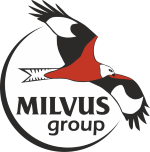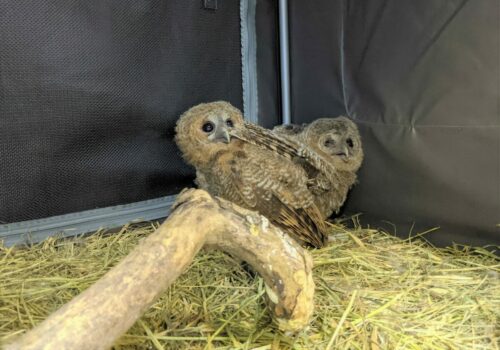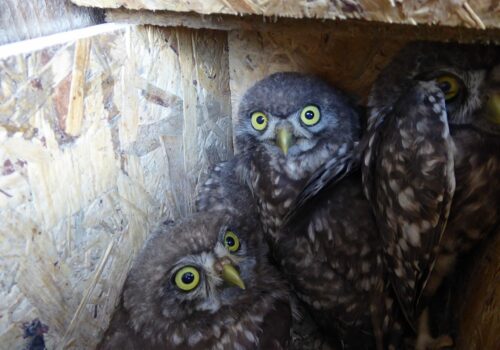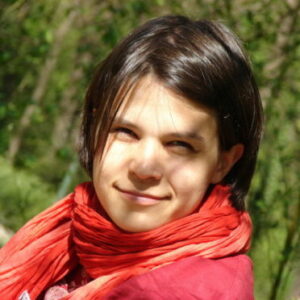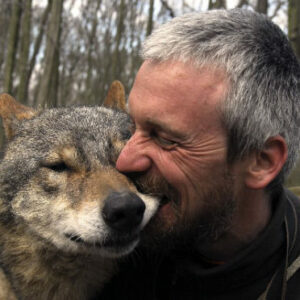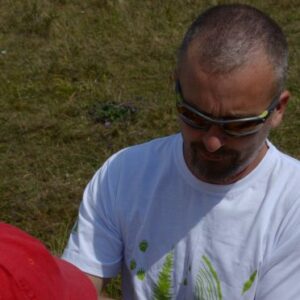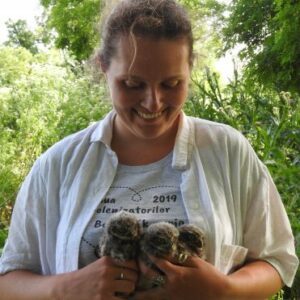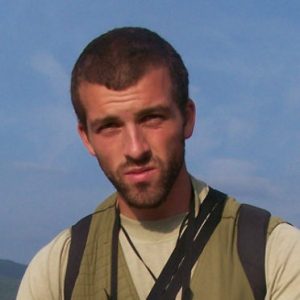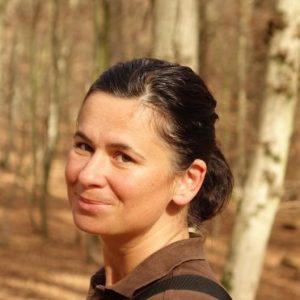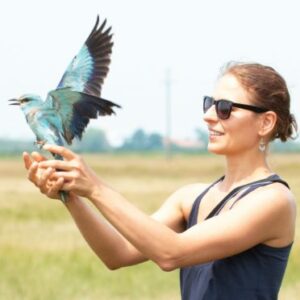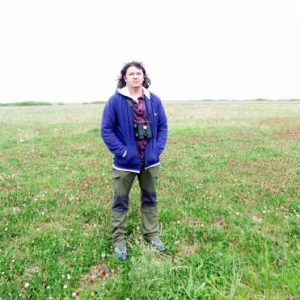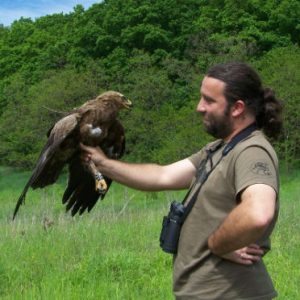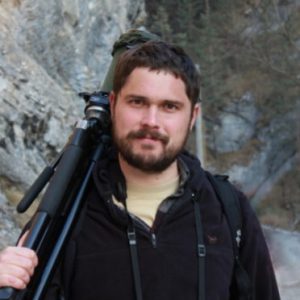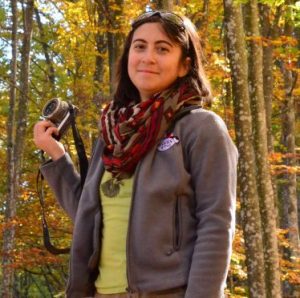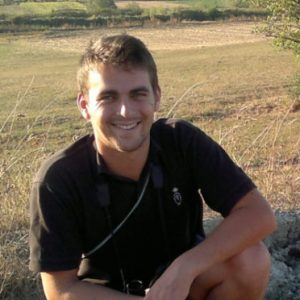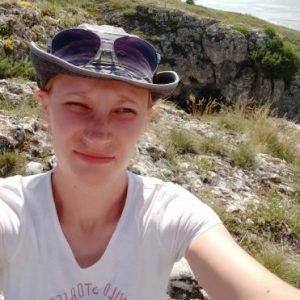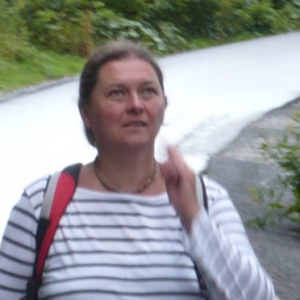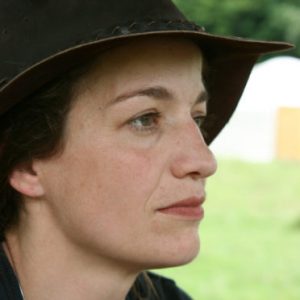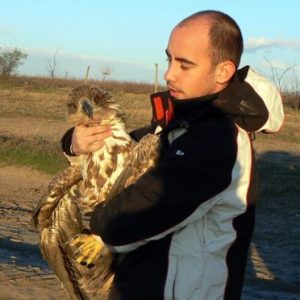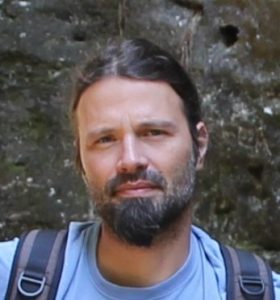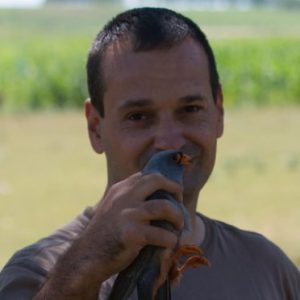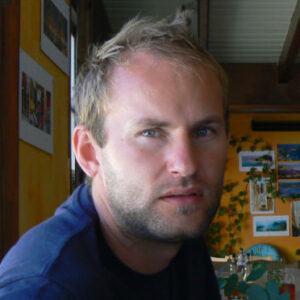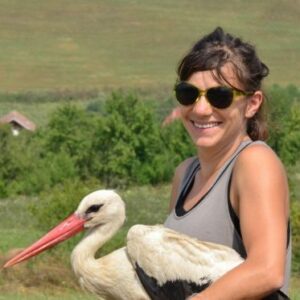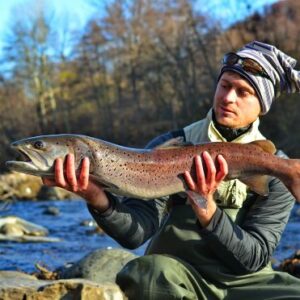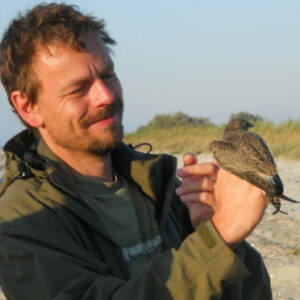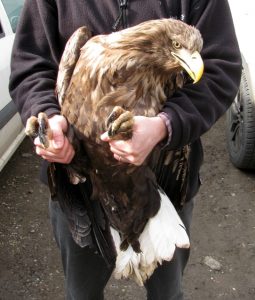
At noon on a Thursday in February, the musician Andrei Dinescu was walking on the banks of Danube near Cetate in Southern Romania when he came across a huge raptor. The beautiful bird was alive but helpless, visibly suffering cramps and spasms in her gut. As he got closer, the bird stood still, breathing deeply and looking straight at him. Realising the bird needed help, Andrei phoned Ferenc Zudor from
Cetate Cultural Port, a cultural centre where Andrei lives. Ferenc came quickly and, together, they took her to the
Cetate Cultural Port. After searching on the internet, they found the
Romanian Ornithological Society (ROS), based in Bucahrest, to whom they sent pictures of the injured bird.
Tamás Papp and András Attila Nagy from
Milvus Group were just leaving from the ROS office towards Tîrgu Mureș when the pictures arrived. They recognised the bird as a White-tailed Eagle, a critically endangered species in Romania that is protected under almost all international conventions. On the spur of the moment, they changed their destination, deciding to head straight to
Cetate Cultural Port instead. People don`t have the chance everyday to save an adult White-tailed Eagle, and speed is crucial in saving injured birds. The journey was long and it was almost 11 o’clock when they arrived to Cetate, where they were greeted by fellow bird lovers and a rapidly deteriorating White-tailed Eagle. After discussing the bird’s symptoms over the phone with the veterinarian Levente Borka (
Vets4Wild Association) they established that the bird had been poisoned. In order to save its life, they had to find atropine which would act as an antidote to the poison – not an easy task to do at midnight in a small rural village.
Andrei called his father, the famous poet and journalist Mircea Dinescu, to see if he could help. Mircea was travelling home at the time and decided to take a detour to Calafat in the neighbouring Dolj County, where he knew a veterinarian who may be able to help. Though asleep and visibly surprised at the midnight request, the vet provided everything he could to help the bird, and soon after Mircea was in Cetate with two phials of atropine and a syringe. Meanwhile the team had been talking on the phone with Déri János, from the
Bird hospital in Hortobágy (Hungary), who told them that they would need much more atropine because the bird would need to be treated throughout the whole night.
After the first round of treatment – 1 ml Atropine and baking soda to neutralize the poison – the bird was put in a dark bathroom. The first hour is the most crucial and the team waited anxiously for it to pass. In the meantime Andrei went to Calafat and brought the more phials of atropine. After an hour the Eagl’s condition hadn’t changed: she stood helplessly, bottom in the air. Her feet and wings were cramped, her pupils were shrunk; all unpromising signs. They gave her a second dose of atropine and settled in for another uneasy hour.
To their surprise, when they returned to the bathroom the situation had improved dramatically. The bird was standing on her legs and, due to the baking soda was retching in an attempt to expel the poisoned meat. During night the bird was checked every hour and a half. In the morning her pupils were shrunk again, so they gave her another half dose of atropine. Before leaving, the visitor took a look at the place where the bird was found. Here they discover fluff remaining from a duck that had been eaten by a raptor and some maize which had most probably been poisoned (the analyses from the laboratory will confirm this fact).
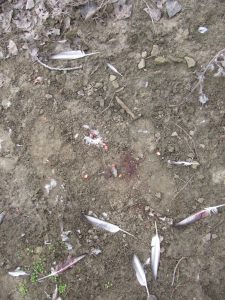
After further investigation, they found out that the locals are poaching ducks too eat, using the extremely irresponsible and dangerous method of poisoning them with
carbofuran infected maize. One duck had flown away before dying and the White-tailed Eagle had caught and eaten it, thus ingesting the poison herself. Carbofuran is forbidden in the European Union, for the dangers it poses both to animals and humans: http://en.wikipedia.org/wiki/Carbofuran.
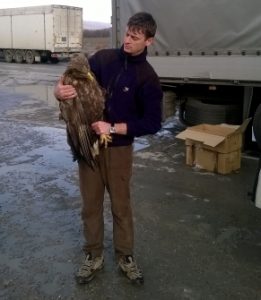
After a long journey with many short breaks, the White-tailed Eagle arrived at the Vets4Wild Association’s veterinary clinic where she received perfusion treatment from Levente Borka. Afterwards she was kept in the
Rehabilitation Centre, where she could recover and exercise flying. A week after she had recovered completely and a team (Levente Borka, Gergely Zoltán Nagy, Róbert Zeitz, Tamás Papp) took her back to Port Cultural Cetate. Before she was released, Andrei decided to name her Attila, apparently unconcerned that he was giving man’s name to a female bird. After she was ringed a satellite transmitter was mounted on her back to monitories her movements.
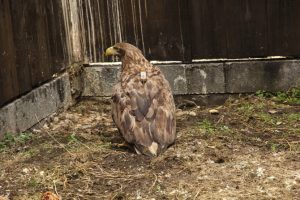
Andrei – as it was him who found the bird saved her life – was given the honours of releasing the Eagle. Her first fly was very promising; she flew for one kilometer before landing. For everyone, it was a moment of true satisfaction; a week ago this magnificent and rare creature was dying. Now, she is healthy, flying and free again. It is these moments which give us determination and energy to continue with our work.
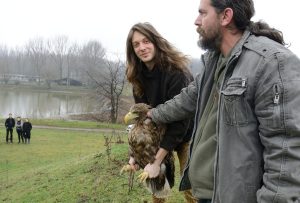
Before they returned home, the team spent the evening enjoying the hospitality of the Dinescu family at Port Cultural Cetate; a unique and wonderful place. Long after dark had fallen, they heard six gunshots. Everyone’s hearts seemed to skip a beat – although every raptor birds is protected in Romania, poaching isn`t rare in the country. Had all their work been in vain?
In morning, their fears were undone; walking the banks of the Danube, they saw the White-tailed Eagle taking a bath in the far side river, up close to the Bulgarian bank. Though she was a kilometer away from where they stood, they could see the satellite transmitter glint for a moment in the sun.

The team left home satisfied, they had done everything to save this bird. Now, we will watch her movements keenly through the satellite transmitter, hoping she comes to no more harm.
 At noon on a Thursday in February, the musician Andrei Dinescu was walking on the banks of Danube near Cetate in Southern Romania when he came across a huge raptor. The beautiful bird was alive but helpless, visibly suffering cramps and spasms in her gut. As he got closer, the bird stood still, breathing deeply and looking straight at him. Realising the bird needed help, Andrei phoned Ferenc Zudor from Cetate Cultural Port, a cultural centre where Andrei lives. Ferenc came quickly and, together, they took her to the Cetate Cultural Port. After searching on the internet, they found the Romanian Ornithological Society (ROS), based in Bucahrest, to whom they sent pictures of the injured bird.Tamás Papp and András Attila Nagy from Milvus Group were just leaving from the ROS office towards Tîrgu Mureș when the pictures arrived. They recognised the bird as a White-tailed Eagle, a critically endangered species in Romania that is protected under almost all international conventions. On the spur of the moment, they changed their destination, deciding to head straight to Cetate Cultural Port instead. People don`t have the chance everyday to save an adult White-tailed Eagle, and speed is crucial in saving injured birds. The journey was long and it was almost 11 o’clock when they arrived to Cetate, where they were greeted by fellow bird lovers and a rapidly deteriorating White-tailed Eagle. After discussing the bird’s symptoms over the phone with the veterinarian Levente Borka (Vets4Wild Association) they established that the bird had been poisoned. In order to save its life, they had to find atropine which would act as an antidote to the poison – not an easy task to do at midnight in a small rural village.
Andrei called his father, the famous poet and journalist Mircea Dinescu, to see if he could help. Mircea was travelling home at the time and decided to take a detour to Calafat in the neighbouring Dolj County, where he knew a veterinarian who may be able to help. Though asleep and visibly surprised at the midnight request, the vet provided everything he could to help the bird, and soon after Mircea was in Cetate with two phials of atropine and a syringe. Meanwhile the team had been talking on the phone with Déri János, from the Bird hospital in Hortobágy (Hungary), who told them that they would need much more atropine because the bird would need to be treated throughout the whole night.
After the first round of treatment – 1 ml Atropine and baking soda to neutralize the poison – the bird was put in a dark bathroom. The first hour is the most crucial and the team waited anxiously for it to pass. In the meantime Andrei went to Calafat and brought the more phials of atropine. After an hour the Eagl’s condition hadn’t changed: she stood helplessly, bottom in the air. Her feet and wings were cramped, her pupils were shrunk; all unpromising signs. They gave her a second dose of atropine and settled in for another uneasy hour.
To their surprise, when they returned to the bathroom the situation had improved dramatically. The bird was standing on her legs and, due to the baking soda was retching in an attempt to expel the poisoned meat. During night the bird was checked every hour and a half. In the morning her pupils were shrunk again, so they gave her another half dose of atropine. Before leaving, the visitor took a look at the place where the bird was found. Here they discover fluff remaining from a duck that had been eaten by a raptor and some maize which had most probably been poisoned (the analyses from the laboratory will confirm this fact).
At noon on a Thursday in February, the musician Andrei Dinescu was walking on the banks of Danube near Cetate in Southern Romania when he came across a huge raptor. The beautiful bird was alive but helpless, visibly suffering cramps and spasms in her gut. As he got closer, the bird stood still, breathing deeply and looking straight at him. Realising the bird needed help, Andrei phoned Ferenc Zudor from Cetate Cultural Port, a cultural centre where Andrei lives. Ferenc came quickly and, together, they took her to the Cetate Cultural Port. After searching on the internet, they found the Romanian Ornithological Society (ROS), based in Bucahrest, to whom they sent pictures of the injured bird.Tamás Papp and András Attila Nagy from Milvus Group were just leaving from the ROS office towards Tîrgu Mureș when the pictures arrived. They recognised the bird as a White-tailed Eagle, a critically endangered species in Romania that is protected under almost all international conventions. On the spur of the moment, they changed their destination, deciding to head straight to Cetate Cultural Port instead. People don`t have the chance everyday to save an adult White-tailed Eagle, and speed is crucial in saving injured birds. The journey was long and it was almost 11 o’clock when they arrived to Cetate, where they were greeted by fellow bird lovers and a rapidly deteriorating White-tailed Eagle. After discussing the bird’s symptoms over the phone with the veterinarian Levente Borka (Vets4Wild Association) they established that the bird had been poisoned. In order to save its life, they had to find atropine which would act as an antidote to the poison – not an easy task to do at midnight in a small rural village.
Andrei called his father, the famous poet and journalist Mircea Dinescu, to see if he could help. Mircea was travelling home at the time and decided to take a detour to Calafat in the neighbouring Dolj County, where he knew a veterinarian who may be able to help. Though asleep and visibly surprised at the midnight request, the vet provided everything he could to help the bird, and soon after Mircea was in Cetate with two phials of atropine and a syringe. Meanwhile the team had been talking on the phone with Déri János, from the Bird hospital in Hortobágy (Hungary), who told them that they would need much more atropine because the bird would need to be treated throughout the whole night.
After the first round of treatment – 1 ml Atropine and baking soda to neutralize the poison – the bird was put in a dark bathroom. The first hour is the most crucial and the team waited anxiously for it to pass. In the meantime Andrei went to Calafat and brought the more phials of atropine. After an hour the Eagl’s condition hadn’t changed: she stood helplessly, bottom in the air. Her feet and wings were cramped, her pupils were shrunk; all unpromising signs. They gave her a second dose of atropine and settled in for another uneasy hour.
To their surprise, when they returned to the bathroom the situation had improved dramatically. The bird was standing on her legs and, due to the baking soda was retching in an attempt to expel the poisoned meat. During night the bird was checked every hour and a half. In the morning her pupils were shrunk again, so they gave her another half dose of atropine. Before leaving, the visitor took a look at the place where the bird was found. Here they discover fluff remaining from a duck that had been eaten by a raptor and some maize which had most probably been poisoned (the analyses from the laboratory will confirm this fact).
 After further investigation, they found out that the locals are poaching ducks too eat, using the extremely irresponsible and dangerous method of poisoning them with carbofuran infected maize. One duck had flown away before dying and the White-tailed Eagle had caught and eaten it, thus ingesting the poison herself. Carbofuran is forbidden in the European Union, for the dangers it poses both to animals and humans: http://en.wikipedia.org/wiki/Carbofuran.
After further investigation, they found out that the locals are poaching ducks too eat, using the extremely irresponsible and dangerous method of poisoning them with carbofuran infected maize. One duck had flown away before dying and the White-tailed Eagle had caught and eaten it, thus ingesting the poison herself. Carbofuran is forbidden in the European Union, for the dangers it poses both to animals and humans: http://en.wikipedia.org/wiki/Carbofuran.
 After a long journey with many short breaks, the White-tailed Eagle arrived at the Vets4Wild Association’s veterinary clinic where she received perfusion treatment from Levente Borka. Afterwards she was kept in the Rehabilitation Centre, where she could recover and exercise flying. A week after she had recovered completely and a team (Levente Borka, Gergely Zoltán Nagy, Róbert Zeitz, Tamás Papp) took her back to Port Cultural Cetate. Before she was released, Andrei decided to name her Attila, apparently unconcerned that he was giving man’s name to a female bird. After she was ringed a satellite transmitter was mounted on her back to monitories her movements.
After a long journey with many short breaks, the White-tailed Eagle arrived at the Vets4Wild Association’s veterinary clinic where she received perfusion treatment from Levente Borka. Afterwards she was kept in the Rehabilitation Centre, where she could recover and exercise flying. A week after she had recovered completely and a team (Levente Borka, Gergely Zoltán Nagy, Róbert Zeitz, Tamás Papp) took her back to Port Cultural Cetate. Before she was released, Andrei decided to name her Attila, apparently unconcerned that he was giving man’s name to a female bird. After she was ringed a satellite transmitter was mounted on her back to monitories her movements.
 Andrei – as it was him who found the bird saved her life – was given the honours of releasing the Eagle. Her first fly was very promising; she flew for one kilometer before landing. For everyone, it was a moment of true satisfaction; a week ago this magnificent and rare creature was dying. Now, she is healthy, flying and free again. It is these moments which give us determination and energy to continue with our work.
Andrei – as it was him who found the bird saved her life – was given the honours of releasing the Eagle. Her first fly was very promising; she flew for one kilometer before landing. For everyone, it was a moment of true satisfaction; a week ago this magnificent and rare creature was dying. Now, she is healthy, flying and free again. It is these moments which give us determination and energy to continue with our work.
 Before they returned home, the team spent the evening enjoying the hospitality of the Dinescu family at Port Cultural Cetate; a unique and wonderful place. Long after dark had fallen, they heard six gunshots. Everyone’s hearts seemed to skip a beat – although every raptor birds is protected in Romania, poaching isn`t rare in the country. Had all their work been in vain?
In morning, their fears were undone; walking the banks of the Danube, they saw the White-tailed Eagle taking a bath in the far side river, up close to the Bulgarian bank. Though she was a kilometer away from where they stood, they could see the satellite transmitter glint for a moment in the sun.
Before they returned home, the team spent the evening enjoying the hospitality of the Dinescu family at Port Cultural Cetate; a unique and wonderful place. Long after dark had fallen, they heard six gunshots. Everyone’s hearts seemed to skip a beat – although every raptor birds is protected in Romania, poaching isn`t rare in the country. Had all their work been in vain?
In morning, their fears were undone; walking the banks of the Danube, they saw the White-tailed Eagle taking a bath in the far side river, up close to the Bulgarian bank. Though she was a kilometer away from where they stood, they could see the satellite transmitter glint for a moment in the sun.
 The team left home satisfied, they had done everything to save this bird. Now, we will watch her movements keenly through the satellite transmitter, hoping she comes to no more harm.
The team left home satisfied, they had done everything to save this bird. Now, we will watch her movements keenly through the satellite transmitter, hoping she comes to no more harm.
